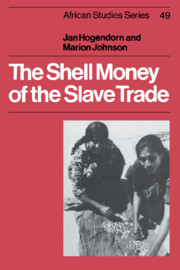Book contents
- Frontmatter
- Contents
- Maps
- Tables and chart
- Preface
- Introduction
- 1 The cowrie
- 2 The Maldive Islands
- 3 The Portuguese domination
- 4 The Dutch and English enter the trade (seventeenth century)
- 5 Prosperity for the cowrie commerce (eighteenth century)
- 6 Boom and slump for the cowrie trade (nineteenth century)
- 7 Collection, transport and distribution
- 8 Cowries in Africa
- 9 The cowrie as money: transport costs, values and inflation
- 10 The last of the cowrie
- Notes
- Bibliogaphy
- Index
9 - The cowrie as money: transport costs, values and inflation
Published online by Cambridge University Press: 12 October 2009
- Frontmatter
- Contents
- Maps
- Tables and chart
- Preface
- Introduction
- 1 The cowrie
- 2 The Maldive Islands
- 3 The Portuguese domination
- 4 The Dutch and English enter the trade (seventeenth century)
- 5 Prosperity for the cowrie commerce (eighteenth century)
- 6 Boom and slump for the cowrie trade (nineteenth century)
- 7 Collection, transport and distribution
- 8 Cowries in Africa
- 9 The cowrie as money: transport costs, values and inflation
- 10 The last of the cowrie
- Notes
- Bibliogaphy
- Index
Summary
How transport costs affected the cowrie's suitability as a circulating medium of exchange under West African conditions, and how well it held its value over time – such questions are an important test of any money.
TRANSPORT
Unlike the transport of cowries by sea, where as ballast the opportunity cost of shipping them might be low, on land their carriage could be so expensive as to affect their relative values from place to place. Since the movement of the shells in West Africa was always accomplished by private enterprise, their value when put into circulation had to be sufficiently high to cover the cost of transport and provide their carriers with a reasonable profit margin.
Canoe. The very cheapest form of transport within West Africa, whenever it was available, was by canoe. A rough estimate of the proportional increase in costs with distance travelled can be made with data for canoe transport on the Volta River and thence to Salaga in 1876.
On the Volta, M.-J. Bonnat purchased a canoe carrying probably about a ton of freight for 25 heads of cowries. The head at that time and place was 50 strings of 35 shells each, i.e. 1,750 cowries, which he valued at “10 dollars and one shilling.” He hired five or six men to a canoe at $3 a month each, and took on additional men at each of the many rapids, at one shilling per person plus three pence for subsistence. For a normal journey of something under a month, wages would thus work out at some $15 to $18 per canoe plus perhaps as much again for additional labor at the various rapids.
- Type
- Chapter
- Information
- The Shell Money of the Slave Trade , pp. 125 - 147Publisher: Cambridge University PressPrint publication year: 1986

